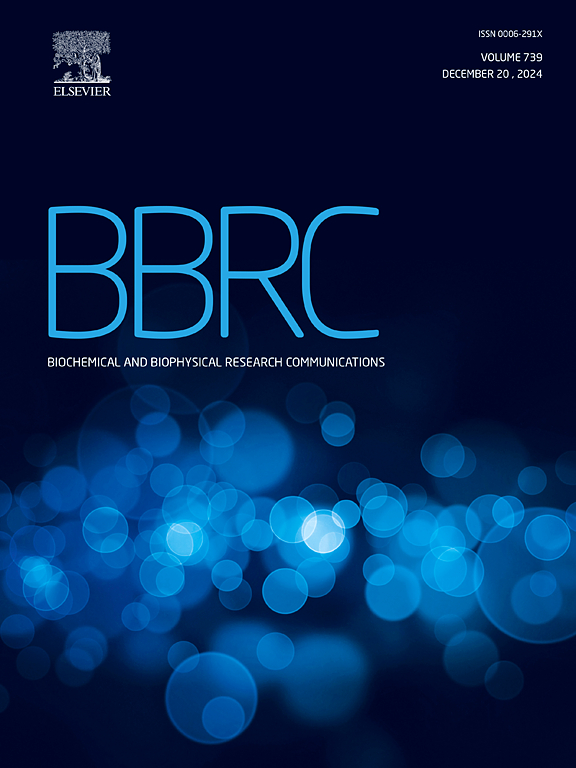Screening ligands interacting with NDUFS3 from Oroxylum indicum extract using bioaffinity ultrafiltration combined with in vitro protein purification
IF 2.5
3区 生物学
Q3 BIOCHEMISTRY & MOLECULAR BIOLOGY
Biochemical and biophysical research communications
Pub Date : 2025-05-23
DOI:10.1016/j.bbrc.2025.152078
引用次数: 0
Abstract
Oroxylum indicum (O. indicum) is a common traditional Chinese medicine, but its neuroprotective effects in Parkinson's disease (PD) model have not been fully elaborated. Mitochondrial complex I dysfunction is the core pathology of oxidative stress injury in PD, and the mechanism of regulating the activity of its key subunit NADH: Ubiquinone Oxidoreductase Core Subunit S3 (NDUFS3) has not been clarified. To explore the potential therapeutic effects of O. indicum on PD and reveal the potential active compounds and molecular mechanism of action behind the treatment of PD by O indicum extract (OIE), in the present study, the mitochondrial complex I subunit NDUFS3 was selected as the PD disease target, and a “three-in-one” system combing target purification of NDUFS3 protein, affinity ultrafiltration screening and validation-analysis of molecular mechanism was constructed. Results suggest that the active compounds in O indicum screened by affinity screening can target and regulate the expression of NDUFS3, lower the mitochondrial membrane potential, reduce oxidative stress, and increase the ATP content, thus exerting anti-PD effects at the cellular and animal levels. The integrated approach of protein purification, affinity ultrafiltration screening and pharmacological validation is pivotal for efficiently identifying active compounds and uncovering their mechanisms in anti-PD research, thereby proving a reference for drug discovery of neurodegenerative diseases.
采用生物亲和超滤结合体外蛋白纯化技术筛选籼米提取物中与NDUFS3相互作用的配体
Oroxylum indicum (O. indicum)是一种常见的中药,但其对帕金森病(PD)模型的神经保护作用尚未得到充分阐述。线粒体复合体I功能障碍是PD氧化应激损伤的核心病理机制,其关键亚基NADH:泛醌氧化还原酶核心亚基S3 (NDUFS3)活性的调控机制尚不清楚。为探索籼稻对帕金森病的潜在治疗作用,揭示籼稻提取物(OIE)治疗帕金森病的潜在活性化合物及其分子作用机制,本研究选择线粒体复合体I亚基NDUFS3作为帕金森病靶点,构建NDUFS3蛋白靶点纯化、亲和超滤筛选和分子机制验证分析“三位一体”的体系。结果表明,亲和筛选的O indicum中活性化合物能够靶向并调节NDUFS3的表达,降低线粒体膜电位,降低氧化应激,增加ATP含量,从而在细胞和动物水平上发挥抗pd作用。蛋白质纯化、亲和超滤筛选和药理学验证相结合的方法是抗pd研究中有效鉴定活性化合物并揭示其作用机制的关键,从而为神经退行性疾病的药物发现提供参考。
本文章由计算机程序翻译,如有差异,请以英文原文为准。
求助全文
约1分钟内获得全文
求助全文
来源期刊
CiteScore
6.10
自引率
0.00%
发文量
1400
审稿时长
14 days
期刊介绍:
Biochemical and Biophysical Research Communications is the premier international journal devoted to the very rapid dissemination of timely and significant experimental results in diverse fields of biological research. The development of the "Breakthroughs and Views" section brings the minireview format to the journal, and issues often contain collections of special interest manuscripts. BBRC is published weekly (52 issues/year).Research Areas now include: Biochemistry; biophysics; cell biology; developmental biology; immunology
; molecular biology; neurobiology; plant biology and proteomics

 求助内容:
求助内容: 应助结果提醒方式:
应助结果提醒方式:


